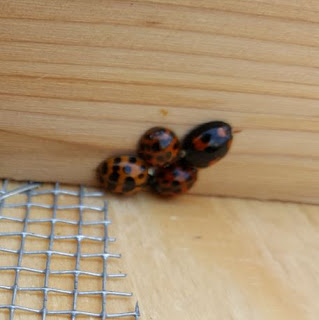Just finished reading Universal : A guide to the Cosmos by Brian Cox and Jeff Forshaw and thought it might be worth sharing a few thoughts about this very interesting book.
Universal aims to take the reader on a journey that shows how, from very simple beginnings, we can use observations of the world around us to answer surprisingly big questions such as "How much does the earth weigh?" and "How far away are stars?
To take one example, Universal mentions the experiment performed by Lord Rayleigh to give an upper limit to the size of an atom. NSB had a try at it and you can too - all you need is some cooking oil, a paperclip, a ruler and a bowl of water.
Equally simply, if given a suitable landmark off the coast and using a little geometry [developed by Al-Biruni], one can hazard a guess as to the size of the earth - something that the book describes using the geography of from Ogmore-on-Sea.
NSB, living far from the coast, had a bash at replicating the experiment using suitable seaside photographs on the Internet, specifically this image of Keros taken from Koufonissia.
Universal goes on to look at the distance to the stars and the size of the universe, taking time to gently explain to the reader how data was corroborated at each step
Indeed, if you are an amateur astronomer with a small telescope in your garden and some photographic equipment; and make an assumption or two; you can show that the universe is expanding, and at what approximate rate!
An important point that Universal makes is explaining how science works and how our confidence in measurements is strengthened when they can be determined via different techniques - for example, there is confidence in the age of the solar system being ~4.6billion years because estimates of the age of the sun (using knowledge about nuclear fusion and the heat received by the earth) and estimates of the age of the earth (using knowledge about radioactive decay in rocks) both give values around this figure. As the book comments:
The book also mentions the words of Richard Feynman:
Another point that is made is how hard, and for how long, people have worked to obtain key pieces of information, such as the distance from the Earth to the Sun.
Towards the end of the book, having taken the reader on an incredible journey through space, time (and space-time), Cosmos ponders why the universe is the way it is, so finely tuned to allow the formation of suns, planets, water and us. The book also explores theoretical possibilities such as that of the "multiverse"
Related NSB Stuff:
Fee- An Autobiography Curiosity, Twitter and the British Connection
Interview with Prof Aragon-Salamanca
Interview with Prof Chris Lintott
Some background to the Space Shuttle
Lecture by Chris Lintott on 2011 Astronomy highlights
Universal aims to take the reader on a journey that shows how, from very simple beginnings, we can use observations of the world around us to answer surprisingly big questions such as "How much does the earth weigh?" and "How far away are stars?
To take one example, Universal mentions the experiment performed by Lord Rayleigh to give an upper limit to the size of an atom. NSB had a try at it and you can too - all you need is some cooking oil, a paperclip, a ruler and a bowl of water.
 |
| The oil drop NSB used to estimate the maximum size of an atom |
Equally simply, if given a suitable landmark off the coast and using a little geometry [developed by Al-Biruni], one can hazard a guess as to the size of the earth - something that the book describes using the geography of from Ogmore-on-Sea.
NSB, living far from the coast, had a bash at replicating the experiment using suitable seaside photographs on the Internet, specifically this image of Keros taken from Koufonissia.
Universal goes on to look at the distance to the stars and the size of the universe, taking time to gently explain to the reader how data was corroborated at each step
Indeed, if you are an amateur astronomer with a small telescope in your garden and some photographic equipment; and make an assumption or two; you can show that the universe is expanding, and at what approximate rate!
 |
| NGC 4414, about 60million light years away (The Hubble Heritage Team) |
An important point that Universal makes is explaining how science works and how our confidence in measurements is strengthened when they can be determined via different techniques - for example, there is confidence in the age of the solar system being ~4.6billion years because estimates of the age of the sun (using knowledge about nuclear fusion and the heat received by the earth) and estimates of the age of the earth (using knowledge about radioactive decay in rocks) both give values around this figure. As the book comments:
"It is easy to cook up a scenario, however fanciful, that casts doubt on some measurement or other. But it is usually extremely difficult to argue for a radical change in one area without making large parts of the whole interlinked [scientific] edifice inconsistent"
The book also mentions the words of Richard Feynman:
"In general, we look for a new law by the following process: First we guess it; then we compute the consequences of the guess to see what would be implied if this law that we guessed is right; then we compare the result of the computation to nature, with experiment or experience, compare it directly with observation, to see if it works. If it disagrees with experiment, it is wrong. In that simple statement is the key to science. It does not make any difference how beautiful your guess is, it does not make any difference how smart you are, who made the guess, or what his name is — if it disagrees with experiment, it is wrong.”
Another point that is made is how hard, and for how long, people have worked to obtain key pieces of information, such as the distance from the Earth to the Sun.
Towards the end of the book, having taken the reader on an incredible journey through space, time (and space-time), Cosmos ponders why the universe is the way it is, so finely tuned to allow the formation of suns, planets, water and us. The book also explores theoretical possibilities such as that of the "multiverse"
 |
| Universal : A Guide to the Cosmos |
Related NSB Stuff:
Fee- An Autobiography Curiosity, Twitter and the British Connection
Interview with Prof Aragon-Salamanca
Interview with Prof Chris Lintott
Some background to the Space Shuttle
Lecture by Chris Lintott on 2011 Astronomy highlights
















































































